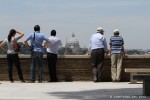

| ||||||
Hills of RomeThe seven hills of Rome designate the traditional hills on which the city developed from its beginnings. They are: the Palatine hill, the Capitolium, the Aventine hill, the Esquiline hill, the Viminal hill, the Caelian Hill and the Quirinal hill. Under the Republic, from the 6th century BC, they were included inside the Servien wall. But subsequently the city expanded far beyond, encompassing higher mountains like Monte Mario or the Janiculan hill on the other side of the Tiber. Palatine, the hill of powerPopulated at least since the 10th century BC, the Palatine hill is the hill where according to legend Romulus founded Rome. Under the republic the patricians were settled there. Today the place is known for the remains of the palaces of the first Roman emperors, who gave its name to the hill, starting with Augustus. CapitoliumIt was the first citadel of Rome, the heart of the city’s cults. From its famous Tarpeian Rock the traitors were thrown into the void. Legend has it that the sabines were installed there. Aventine, the hill of the plebeiansThe hill with its two peaks integrated Rome at the time of the kings. Near the port on the Tiber, a merchant colony developed there and foreigners often settled here, with temples of distant cults. Under the Republic, it was the traditional seat of the plebeians, the small people. Under the empire aristocratic mansions were built, razed during the sacking of Rome in the 5th century. Nowadays is a quiet area with monasteries and churches. Quirinal hillThis hill was traditionally occupied by the sabines, then rich neighborhood with several temples. Caelius hillUnder the Republic it was the district of the rich Romans, and under the empire the Temple of Claude was built, then at its feet Caracalla built the great baths. Nowadays, there are parks, churches and hospitals. Esquiline hillPart of this hill, the Oppius, was occupied by the majestic residence of Nero with its golds that he built after the Great Fire of Rome in 64 AD, near the Colosseum below. Trajan beat thermal baths there. A large part now extends to the vicinity of Termini. Viminal hillSmall hill, there were temples and baths. It was separated from the Esquiline by the Suburra district, considered as the slums of ancient Rome  Rome reveals exceptional views from its emblematic heights and viewpoints. This page explores panoramic sites such as Piazzale Garibaldi on the Janicule hill, the Pincio terrace overlooking Piazza del Popolo, and the Orange Garden on Aventine hill with its view of the Tiber, or from the Monte Mario, the highest Roman summit. | ||||||
| Copyright © 2025 www.bestofrome.fr : Rome Visit - Tous droits réservés, reproduction même partielle non autorisée - Contact - Cookies, informations et confidentialité | ||||||
Recents comments